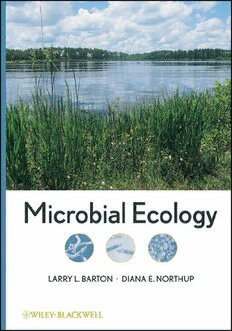
Microbial Ecology PDF
Preview Microbial Ecology
MICROBIAL ECOLOGY MICROBIAL ECOLOGY Larry L. Barton and Diana E. Northup A JOHN WILEY & SONS, INC., PUBLICATION Copyright2011byWiley-Blackwell.Allrightsreserved. PublishedbyJohnWiley&Sons,Inc.,Hoboken,NewJersey PublishedsimultaneouslyinCanada Wiley-BlackwellisanimprintofJohnWiley&Sons,formedbythemerger ofWiley’sglobalScientific,TechnicalandMedicalbusinesswithBlackwellPublishing. Nopartofthispublicationmaybereproduced,storedinaretrievalsystem,ortransmittedinanyformorby anymeans,electronic,mechanical,photocopying,recording,scanning,orotherwise,exceptaspermittedunder Section 107 or 108 of the 1976 United States Copyright Act, without either the prior written permission of the Publisher, or authorization through payment of the appropriate per-copy fee to the Copyright Clearance Center,Inc.,222RosewoodDrive,Danvers,MA01923,(978)750-8400,fax(978)750-4470,orontheweb at www.copyright.com. Requests to the Publisher for permission should be addressed to the Permissions Department, John Wiley & Sons, Inc., 111 River Street, Hoboken, NJ 07030, (201) 748-6011, fax (201) 748-6008,oronlineathttp://www.wiley.com/go/permission. Limit of Liability/Disclaimer of Warranty: While the publisher and author have used their best efforts in preparingthisbook,theymakenorepresentationsorwarrantieswithrespecttotheaccuracyorcompleteness ofthecontentsofthisbookandspecificallydisclaimanyimpliedwarrantiesofmerchantabilityorfitnessfora particularpurpose.Nowarrantymaybecreatedorextendedbysalesrepresentativesorwrittensalesmaterials. Theadviceandstrategiescontainedhereinmaynotbesuitableforyoursituation.Youshouldconsultwitha professional where appropriate. Neither the publisher nor author shall be liable for any loss of profit or any othercommercialdamages,includingbutnotlimitedtospecial,incidental,consequential,orotherdamages. Forgeneralinformationonourotherproductsandservicesorfortechnicalsupport,pleasecontactourCustomer CareDepartmentwithintheUnitedStatesat(800)762-2974, outsidetheUnitedStatesat(317)572-3993 or fax(317)572-4002. Wiley also publishes its books in a variety of electronic formats. Some content that appears in print may not be available in electronic formats. For more information about Wiley products, visit our web site at www.wiley.com. LibraryofCongressCataloging-in-PublicationData: Barton,Larry,1940- Microbialecology/LarryL.BartonandDianaE.Northup. p.cm. Includesindex. ISBN978-0-470-04817-7(hardback) 1.Microbialecology.I.Northrup,DianaE.II.Title. QR100.B372011 579(cid:1).17–dc22 2010043470 PrintedintheUnitedStatesofAmerica oBookISBN:978-1-118-01584-1 ePDFISBN:978-1-118-01582-7 ePUBISBN:978-1-118-01583-4 10987654321 Dedicated to Sandra, Kenneth, and the many students who inspired us to write this book CONTENTS PREFACE xvii GLOSSARY xix 1 MICROBIALECOLOGY:BEGINNINGSANDTHEROADFORWARD 1 1.1 Central Themes 1 1.2 Introduction 2 1.2.1 Roots of Microbial Ecology 3 1.2.2 Current Perspectives 4 1.3 Timeline 5 1.4 Microfossils 7 1.5 Early Life 9 1.5.1 The Precellular World 9 1.5.2 The First Cell 10 1.5.3 Development of Cellular Biology 11 1.5.4 Evolution of Metabolic Pathways 12 1.6 Characteristics of Microbial Life 13 1.6.1 Structure and Evolution of Cell Shape 13 1.6.2 Metabolism and Use of Energy 16 1.6.3 Growth, Reproduction, and Development 17 1.6.4 Adaptations and Response to Stimuli 18 1.7 Classification and Taxonomy: The Species Concept 18 1.8 The Three Domains: Tree of Life 19 1.9 Relationship of Microbial Ecology to General Ecology 22 1.10 Changing Face of Microbial Ecology 23 1.10.1 Change in Focus 23 1.10.2 Diversity: From Culturing to Molecular Phylogeny 24 1.11 Summary 25 1.12 Delving Deeper: Critical Thinking Questions 26 Bibliographic Material 26 vii viii CONTENTS 2 DIVERSITYOFMICROORGANISMS 29 2.1 Central Themes 29 2.2 The Ubiquity of Microorganisms 29 2.3 The Amazing Diversity of Morphologies 30 2.3.1 Comparison of the Three Domains 32 2.3.2 What’s in a Name: Prokaryotes 32 2.3.3 Winogradsky’s Experiments with Chemolithotrophs 32 2.4 Diversity of Bacterial Groups 33 2.4.1 Expansion of the Number of Bacterial Phyla 33 2.4.2 Bacterial Portrait Gallery: Processes and Players 35 2.5 Discovery of Archaea as a Separate Domain 38 2.6 Archaeal Diversity 39 2.6.1 Archaeal Portrait Gallery 39 2.7 Archaea–Bacteria Differences 45 2.8 Eukarya: A Changing Picture of Phylogenetic Diversity 46 2.9 Protist Diversity 46 2.9.1 Protist Gallery 49 2.10 Fungal Diversity 51 2.11 Algal Diversity 54 2.12 Viral Diversity 56 2.13 Summary 57 2.14 Delving Deeper: Critical Thinking Questions 58 Bibliographic Material 58 3 COMPLEXITYANDSIMPLICITYOFCELLSYSTEMS 61 3.1 Central Themes 61 3.2 Introduction 62 3.3 Cell Parameters 63 3.3.1 Life at the Lowest Level 64 3.3.2 Large Microorganisms 66 3.4 Cell Movement and Chemotaxis 68 3.5 Structures of Sporulation 71 3.6 Nutrient Reserves and Storage Materials 74 3.7 Cell–Cell Associations 75 3.7.1 Cell Attachment 76 3.7.2 Biofilms 78 3.7.3 Filamentous Growth 82 3.8 Cell Physiology and Metabolism 84 3.8.1 Sensory Response 84 3.8.2 Global Regulation 86
